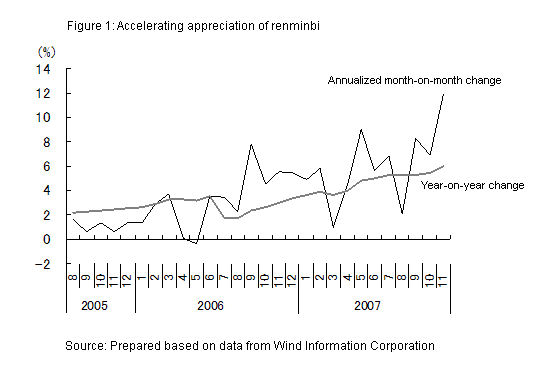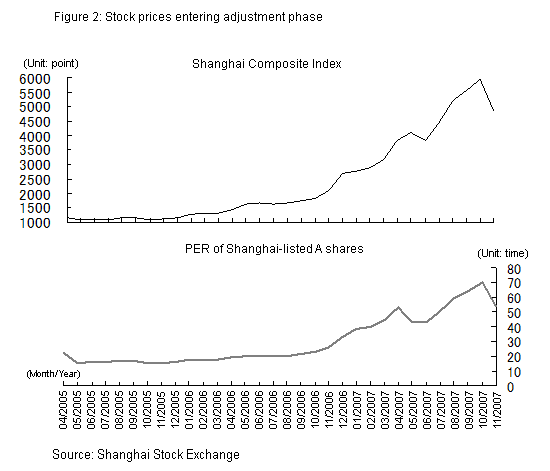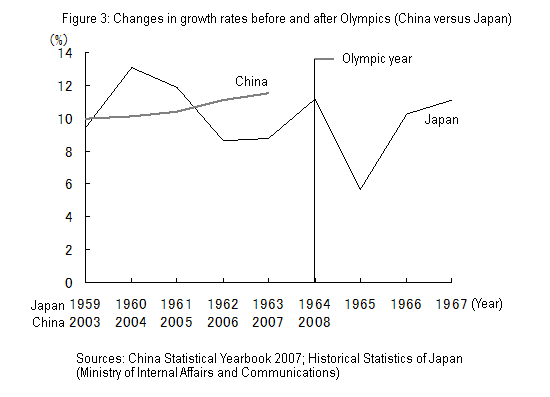Challenges facing management of macroeconomic policy
The year 2008 will be marked in history as the year the Beijing Olympic Games symbolize the rise of China. At the present, however, China is heading into difficult times in its macroeconomic management as the expansion of external surplus and the accompanying increase in liquidity show no signs of ending.
The Chinese economy in 2007 supposedly posted double-digit growth for the fifth consecutive year. Yet asset prices such as stock and real estate prices are already reaching "bubble price" status, while inflation pressure is rising. Against this backdrop, the Chinese central bank has further tightened monetary policy and begun to tolerate accelerated renminbi appreciation, though it is aware that the pace of growth will somewhat taper off as a result (figure 1). Such a propensity will likely strengthen in the coming months.
Future course of inflation and asset bubble being watched closely
The Chinese central bank's repeated interventions to curb the sharp rise of the renminbi have in recent years been causing a rapid increase in the money supply as well as in liquidity. Real estate, stock, and other asset prices have been soaring. This is particularly noticeable where, helped by progress in non-tradable share reform, the Shanghai Stock Exchange Composite Index exceeded 6,000 points on October 15, 2007, the final day of the 17th National Congress of the Communist Party of China (CPC), increasing six-fold in a little over two years. Chinese stock prices have since entered an adjustment phase amid growing concerns that the U.S. subprime loan problem may trigger a slowdown of the world economy, and accompanying a series of large-scale initial public offerings (IPOs) such as that of the China National Petroleum Corporation (CNPC). Yet current share prices are still overvalued with price earning ratios (PERs) exceeding 50 (figure 2). As another cause of concern, the planned lifting of the ban on the sale of state-held non-tradable shares, slated for as early as 2009, could deteriorate the supply-demand relationship in the stock market. Thus, stock prices may fall further.
Meanwhile, riding on growing liquidity, inflation is accelerating. The consumer price index (CPI) for November 2007 rose 6.9% year on year, marking the highest level in 11 years. At this stage, such inflation is mostly attributable to rising food prices. In the coming months, however, additional inflationary pressures will come in the wake of soaring oil prices and wage hikes that reflect inflation expectations. Rising inflation could trigger social unrest, as was the case with the Tiananmen Square protests of 1989. Preventing unrest is the top priority in managing macroeconomic policy for the immediate future. Therefore, the central bank has been accelerating the pace of renminbi appreciation by making fewer currency market interventions while taking steps, such as raising interest rates, to further tighten their stance on monetary policy. Given all those factors, coupled with the expected slowdown of the world economy, it is highly likely that the Chinese economy will reach a turning point in the business cycle before the opening of the Beijing Olympics in August.
Pressing need for cyclical adjustments
As with Japan in the run-up to the 1964 Tokyo Olympics, China has intensively invested in a range of projects in preparation for its Olympics. Thus it is widely anticipated that once the event is over, the economy will snap back from the pre-games boom and take a downturn. Indeed, the Chinese economy is now reaching a stage of development equivalent to that of the Japanese economy around the time of the Tokyo Olympics. However, given that China's population is about 10 times that of Japan, it is reasonable to assume that the present size of the Chinese economy is roughly 10 times that of Japan back in the mid-1960s. Thus, the post-Olympic economic downturn in China will be limited; Beijing and nearby areas will have some adjusting to do because all Olympic-related investments will be gone, but such adjustments will not have a great enough impact to significantly push down the nationwide growth rate.
The possibility of a further inflation surge and subsequent bubble burst are a greater cause of concern. The central bank should have acted more quickly to address the problem of excess liquidity, letting the renminbi rise to a higher level at a much earlier stage, but tried to postpone such adjustments until after the Olympic Games. Thus, larger adjustments are expected.
In terms of development stage, however, China still lags far behind developed countries and thus, by taking full advantage of its latecomer status, should be able to maintain potential growth of nearly 10% for some time. Even if the bubble bursts, it will not be the end of the high-growth period, and the Chinese economy, like the Japanese economy after the Tokyo Olympics, will begin recovering after a relatively short adjustment period (figure 3).





